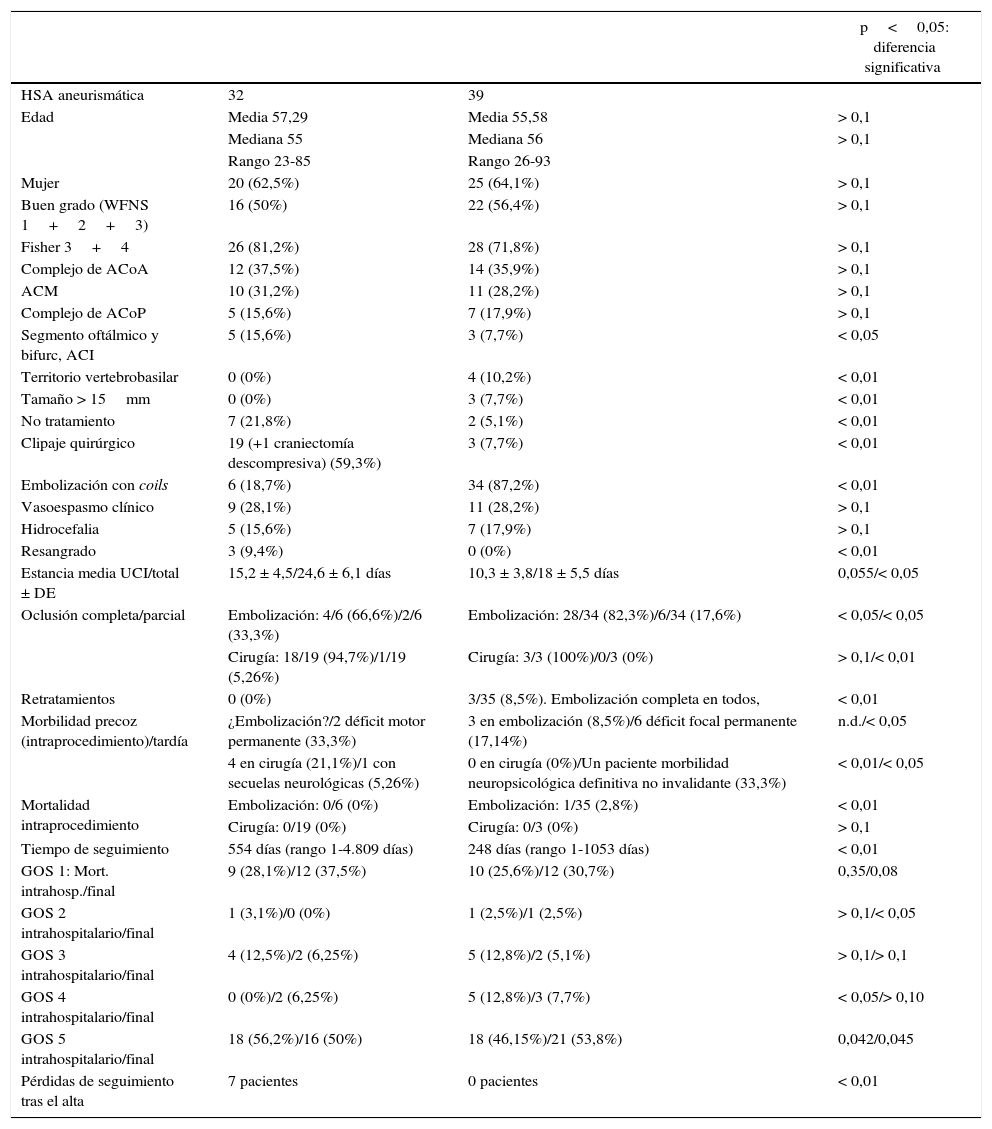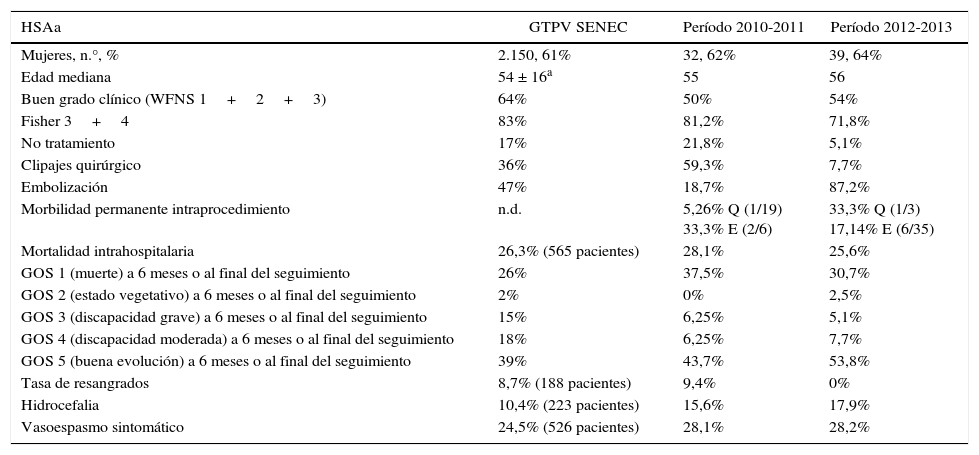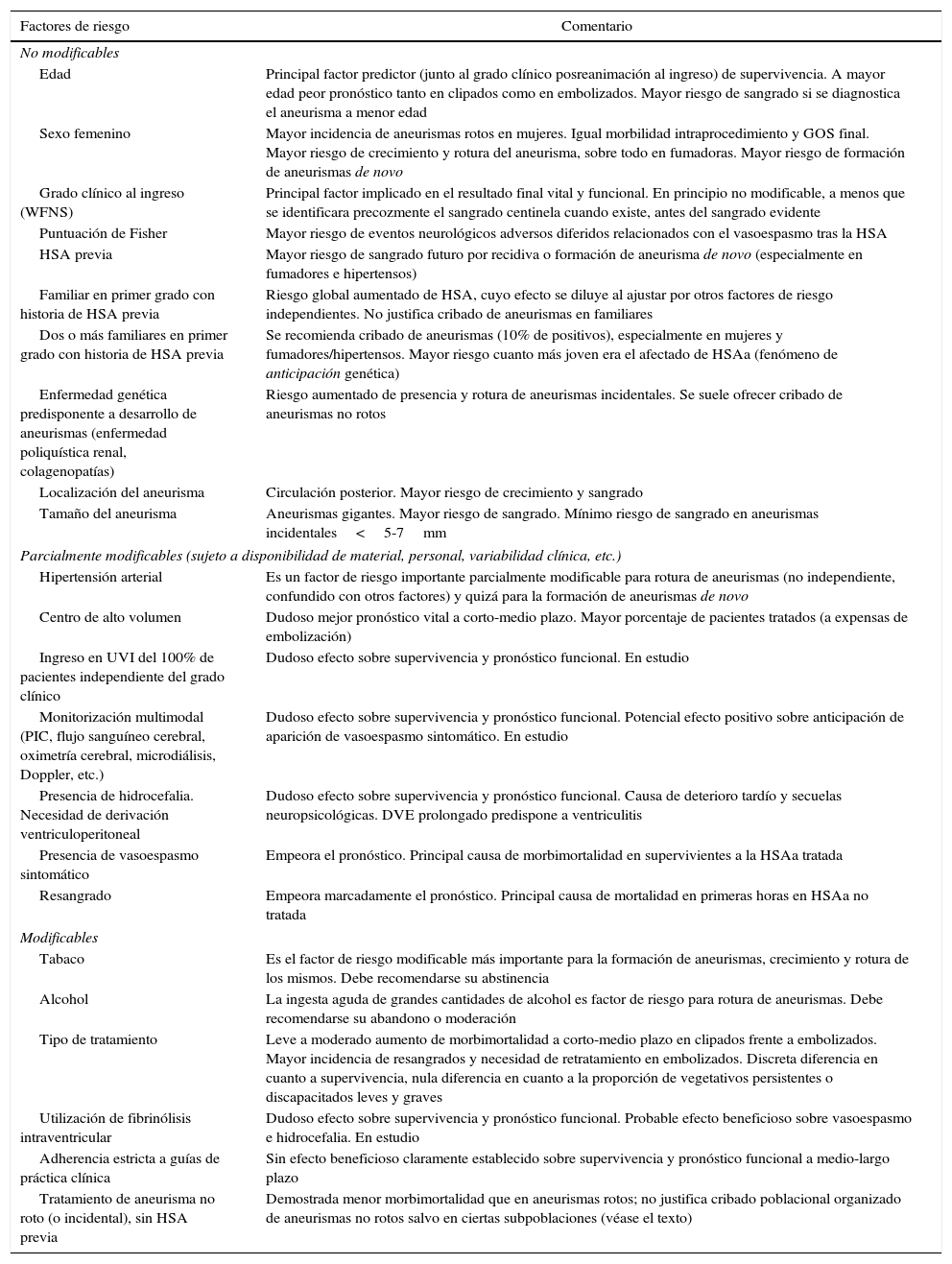Valorar el impacto de la introducción del tratamiento endovascular en pacientes con hemorragia subaracnoidea espontánea aneurismática (HSAa) en un centro de medio-bajo volumen.
Material y métodosEstudio observacional retrospectivo donde se comparan los resultados clínicos de pacientes con HSAa en 2 períodos, antes y después de disponer de tratamiento embolizador. Las variables estudiadas más relevantes fueron: modalidad de tratamiento, mortalidad intrahospitalaria y diferida, complicaciones intraprocedimiento, tasas de resangrado y vasoespasmo, y resultados al final del seguimiento medidos mediante la escala de resultado de Glasgow (GOS).
ResultadosSe trató en total a 71 pacientes en 2 períodos: 2010-2011 (32 pacientes; 19 clipajes, 6 embolizaciones,7 no tratados) y 2012-2013 (39 pacientes; 3 clipajes, 34 embolizaciones, 2 no tratados). Ambas cohortes no presentaron diferencias significativas en cuanto a edad, sexo, grado clínico al ingreso, tipo y localización de los aneurismas y puntuación de Fisher, así como en mortalidad intrahospitalaria (28,1% vs. 25,6%, p=0,35), resultado clínico valorado según la puntuación de GOS (salvo en GOS 5: 43,37% vs. 53,8%, p=0,045), tasa de hidrocefalia e incidencia de vasoespasmo sintomático. La segunda cohorte obtuvo mejores resultados agregados respecto a la primera para GOS 1+2+3 (36,3% vs. 43,75%, p=0,034) y para GOS 4+5 (61,5% vs. 56,25%, p=0,078). El porcentaje de pacientes que no fueron tratados fue significativamente inferior en el segundo período (5,1% vs. 21,8%, p<0,01), así como la tasa de resangrados (0% vs. 9,4%, p<0,01). En el segundo período se trataron los pacientes de forma más precoz (2,51 vs. 3,95 días) y la estancia en Unidad de Cuidados Intensivos y total fueron menores (15,2 y 24,6 vs. 10,3 y 18 días), diferencias en el límite de la significación estadística.
ConclusionesEl tratamiento endovascular permitió tratar un porcentaje mayor de pacientes con HSAa con una disminución en la tasa de resangrados. Este hecho se tradujo en una modesta reducción en la morbimortalidad.
To evaluate the impact of introducing endovascular therapy for patients with aneurysmal subarachnoid haemorrhage (aSAH) in a medium-low volume centre.
Material and methodsA retrospective observational study was conducted by comparing the clinical outcome of patients with aSAH before and after introducing endovascular therapy in our centre. The main variables analysed were: type of treatment, hospital and late mortality, intra-procedural morbidity, rate of re-bleeding and vasospasm, and clinical outcome according to the Glasgow Outcome Score (GOS).
ResultsSeventy-one patients were treated in two periods: 2010-2011 (32 patients; 19 clipped, 6 coiled, 7 untreated), and 2012-2013 (39 patients, 3 clipped, 34 coiled, 2 untreated). No significant differences were found in age, sex, clinical grade at admission, type and location of aneurysm, Fisher score, or in hospital mortality (28.1% vs 25.6%, P=.35), GOS (except for GOS 5: 43.37% vs 53.8%, P=.045), rate of hydrocephalus and rate of vasospasm. The second cohort obtained better results for aggregated GOS 1+2+3 (36.3% vs 43.75%, P=.034) and for GOS 4+5 (61.5% vs 56.25%, P=.078). The percentage of patients left untreated was significantly lower in the second period (5.1% vs 21.8%, P<.01), as well as the rate of re-bleeding (0% vs 9.4%, P<.01). Patients were treated earlier (2.51 vs 3.95 days), and hospital and total stay were lower (15.2 and 24.6 vs 10.3 and 18 days) in the second period, these differences not reaching statistical significance.
ConclusionsEndovascular therapy allowed treating more patients with aSAH, and with a lower re-bleeding rate. This led to a modest reduction in morbidity and mortality.
Article

If it is the first time you have accessed you can obtain your credentials by contacting Elsevier Spain in suscripciones@elsevier.com or by calling our Customer Service at902 88 87 40 if you are calling from Spain or at +34 932 418 800 (from 9 to 18h., GMT + 1) if you are calling outside of Spain.
If you already have your login data, please click here .
If you have forgotten your password you can you can recover it by clicking here and selecting the option ¿I have forgotten my password¿.









